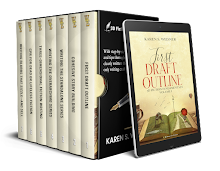{Put This One on Your TBR List}
Book Review: The Graceview
Patient by Caitlin Starling
by Karen S. Wiesner
 Beware
spoilers!
Beware
spoilers! Caitlin Starling's previous new
release, The Starving Saints,
garnered a lukewarm, undeniably disappointed review from me (see
https://aliendjinnromances.blogspot.com/2025/08/put-this-one-on-your-tbr-list-book.html) here on the Alien Romances Blog. As a result, I decided to hold off on purchasing the hardcover of The Graceview Patient, released October 14, 2025, despite that she's written some of my favorite novels (The Luminous Dead and The Death of Jane Lawrence--also reviewed on this blog and accessible with a search). While waiting for the paperback release, the audiobook version became available on one of my library apps so I borrowed it immediately.
In The Graceview Patient, we're set up with what sounds like an
absolutely irresistible horror scenario that was described in promotion as "Misery meets Invasion of the Body Snatchers". Okay, well, more so the
latter than the former definitely got me drooling. Margaret has a rare
autoimmune condition that wrecks any chance of her living a normal life.
Without a cure, she's barely making it day by day until she's offered a spot in
an experimental medical trial that's fully paid for. She'll be forced to live
at Graceview Memorial Hospital full-time and subjecting herself to a treatment
that will all but kill her. The fact that she has no one to go through it with
her (apparently she's alienated every single person she considered relative or
friend) doesn't initially bother her too much. The man in charge of all this,
Adam, is charming in a way that Margaret has no willpower to resist. As the
trial progresses, she begins exploring the hospital and finds something that
only becomes increasingly more sinister the longer her trial goes on.
I'm not gonna lie to you: The early chapters of this book were absolutely brutal--so boring, it was almost painful to force myself to continue. In part it may have been done in this seemingly innocuous way in order to throw the reader off. But I have to comment on two aspects of this: 1) The audiobook was recorded at such a low volume that, even with my speaker hooked up and at full volume, I could barely hear it, and 2) the audiobook narrator had a voice all but designed to put a listener to sleep. I realized later that the intention was to come off sounding like the patient who progressively becomes sicker and sicker. She captured that in spades. Despite that there was a reason the narrator read this book the way she did, it was still difficult to endure. If it hadn't been a Caitlin Starling book, I might not have continued with it all the way through. I am glad I did, though, but the narrator choice did skew my initial perceptions of the story. Do I believe that the ebook or paperback would have been any better? No. I'm almost certain I would have struggled even more with those formats than this one. This book was written like a dry textbook. Only when you were too far into the net to back out did it become exciting and suspenseful. At all times, though, it was like watching a train wreck in slow motion. At no point did that cringing let up.
One further complaint: All throughout the story, the author sprinkled in what could only be perceived as annoying "tell the story before I tell the story" injections, such as things like "maybe I should have been afraid or suspicious by that but I wasn't". If you don't believe you can set up a horror story well enough to be frightening when the time comes, this is the method you'd attempt to make it so. I register a full poo-poo on such a weak and unprofessional delivery system! I was taught early on as an author to never do that, and I agree with the advice wholeheartedly.
All these issues aside, you have to read this full-on horror story! I can't imagine a single person alive not being anguished at the thought of being sick beyond cure, desperate to find any hope at all, and taking a risk however perilous that might lead to life--a risk that never would have been an option until that point. I can promise you that, once you've read The Graceview Patient, you'll never go near a medical facility without wondering what you're getting yourself in for, without being justifiably a little afraid. Do an internet search for "what bacteria/virus/infection is prominent in healthcare settings" and read some of the articles that come up. Do you know there's actually an acronym for contracting an infection that wasn't present at the time of admission while you're receiving medical treatment (HCAI)? Apparently, some believe that medical centers should be completely "restarted" every decade or so, as it's the only way to really avoid HCAI. I didn't delve too deeply into HCAI in large part because I really don't want to know. There's enough horror in life these days without adding to it with a million "what ifs".
The Graceview Patient sneaks up on you. You'll probably start out bored (as I certainly was) and, before you know it, you're canceling your next doctor's appointment because…you know, you're really not as sick as you thought you were. It does a psychological number on you, maybe permanently. You'll never look at health, hospitals, or experimental trials the same way again, let alone what constitutes sentience, what should be allowed to live and thrive… While this recommendation comes with quite a few disclaimers, if you like horror--especially the real-life-this-could-actually-happen!!! kind--you won't want to miss this one.
Karen Wiesner is an award-winning,
multi-genre author of over 150 titles and 16 series.
Visit her website and blog here: https://karenwiesner.weebly.com/
and https://karenwiesner.weebly.com/karens-quill-blog
Visit her publisher here: https://www.writers-exchange.com/Karen-Wiesner/











































